Exudate consists of fluid that leaks out of blood vessels into nearby tissues. The fluid is made of cells, proteins, and solid materials. Exudate may ooze from cuts or from areas of infection or inflammation. It is called pus.
Also, if allowed to dry, the wound will adhere to the overlying wound dressing, making it difficult to remove. However, if wheatgrass extract is applied to the wound before the dressing is applied, it will prevent adhesion of the dressing to the wound, prevent infection and significantly accelerate healing.
By comparison, the orthodox approach to wound healing is quite mechanical. For instance, keeping the wound moist is an outdated concept which is dependent on clinical observation and a considerable amount of wishful thinking that it will assist recovery. After all, skin cells may grow faster in a moist Petri dish, but that doesn't mean they will in an open wound - particularly if it is infected.
Also, exudate is essential to heal any wound, but it is sticky and can readily adhere to dressings making them difficult to remove,
By comparison, if wheatgrass extract is applied to the wound before dressing, it will help:
- Seal the wound surface so that it retains exudate, thereby preventing infection.
- Prevent dressings adhering to the wound surface.
- Reduce inflammation.
- Accelerate healing.
- Prevent or reduce pain.
- Reduce or eliminate scarring.
Now, in 2022, after 28 years experience using wheatgrass extract for wound healing, these outcomes are consistent in that no other treatment has been necessary - in particular, antibiotics, for effective healing. The extract appears not only to accelerate “sealing” of the wound surface, but to also prevent exudate erosion of surrounding skin.
Clearly, ligands present in wheatgrass extract assist re-connection of "disconnected" cell receptors throughout the body, thereby restoring functionality to the affected area. (Please read my theory on how I understand wheatgrass heals).
Subsequently, these benefits can include:
- Accelerated damaged tissue recovery.
- A dry, non-adherent surface. (So the dressing doesn't adhere to the wound surface.)
- Easier self-management - applications and removal of dressings etc.
- Minimal (if any) antibiotic requirement.
- Significant cost and time saving for patient, nursing staff etc.
- Safety. Wound infection and pain are prevented.
Since the 1930’s, cereal grasses were thought to contain “growth factors” that might stimulate re-epithelialisation of acute wounds and burns. However, I believe "re-coupling" of de-coupled connections between the periphery and the central nervous system is what recovers damaged areas.
Wound healing - Orthodox method. Slow and complicated
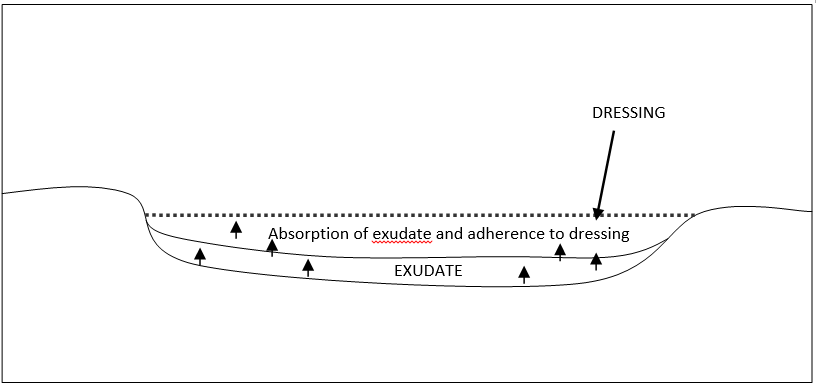
Wound healing - Wheatgrass extract method. Simple and effective
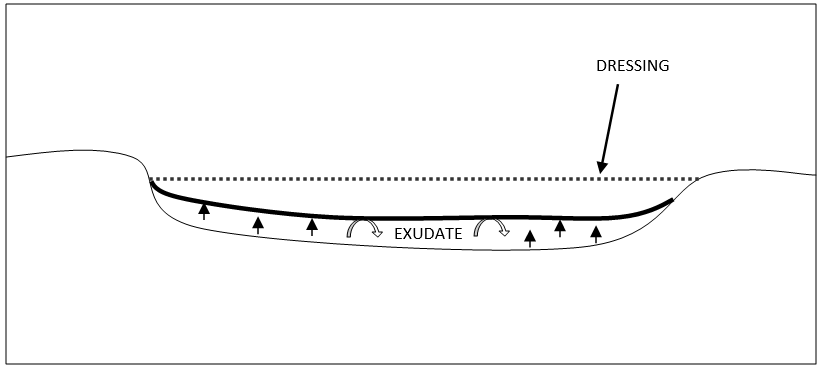
An important healing attribute of wheatgrass is its ability to create a layer of new epithelial cells across open wound surfaces in as little as 24 hours. It appears to seal the wound surface thereby preventing erosion of the skin by exudates surrounding the wound.
Also, because wound recovery continues underneath the "new skin" layer, the dressing does not adhere to the wound, which facilitates removal before re-dressing. Also, rapid re-vascularisation (acceleration of blood flow crucial to the healing process) and re-epithelialisation (skin surface recovery) helps retain exudate which is essential for wounds to heal.
From my many years experience with wheatgrass extract I have no doubt it is remarkably effective, safe and economical as a wound-healing agent.
Note: Wheatgrass extract is also a highly effective treatment for burns by its ability to seal off the wound surface and ensuring that fluid is retained and infection prevented. Pain is often relieved, also. (4)
The next two cases demonstrate how well wheatgrass extract can revitalise damaged tissue and accelerate wound healing.
Case No. 1 – Split lip for one year. Heals rapidly with wheatgrass extract
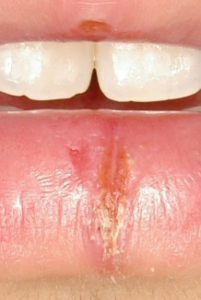
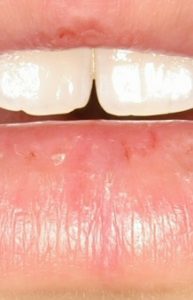
This 20 y.o. male suffered from a very painful split lower lip for 12 months. Prescribed treatments included steroid creams, anti-fungals, antibiotics and emollient creams, none of which healed his wound. However, just 2 weeks after one application of wheatgrass extract, the wound has healed completely.
But how could such a difficult-to-treat wound have healed so quickly?
As I have described elsewhere on this website, it seems to be clear that wheatgrass extract (which has been proven to contain at least 20 ligands) in some way restores the functionality of dysfunctional cell receptors by "reconnecting" them to the brain, which responds accordingly.
Case No. 2 – Wheatgrass accelerates skin graft recovery
A 50 y.o. businessman suffered a deep dog bite to his lower leg. A split skin-graft was applied to the wound and regularly cleansed and covered with antibiotic dressings.
Six weeks later the graft has failed to “take”, most likely due to inadequate blood supply. (Note the depressed, rough surface of the purplish grafted skin, (Fig. 1.) )
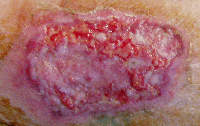
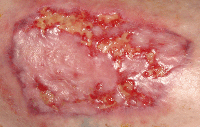
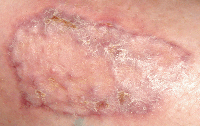
The wound was cleansed, wheatgrass extract applied, then covered with a non-adhesive, light dressing. (Melolin). The patient changed his dressing daily.
Two days later (Fig. 2.) there is already marked improvement. Note the dry surface over the yellow granulation areas where re-epithelialisation has already sealed the wound surface. The depressed areas have now filled in‚ the grafted skin is looking homogeneous and healthy, and is blending seamlessly with the surrounding normal skin. Remarkably, the dressing was freely removed, there being no adherance to the wound.
After 20 days, (Fig. 3.) the wound has healed completely.
Note: Exudate or "leakage" from the wound helps prevent infection by sealing the wound surface and is also essential for the healing process. Without it, the wound surface cannot heal. Wheatgrass extract helps "seal" the wound surface, protecting it from infection, and accelerating the healing process.
How does wheatgrass work?
This article explains to some extent, how the extract can be effective in "normalising/curing" so many medical conditions and injuries. Interestingly, even in the 1930’s cereal grass juices were observed to rapidly heal pus-filled wounds, as well as increase fertility rates in laboratory animals by 85%!
Another study (Reference No. 5.) showed increased production of growth hormone in rats fed green barley (cereal) juice, which most likely plays a part in the healing process.
Dr. Chris Reynolds. M.B.,B.S.
References:
- Jones, V. & Harding, K. (2001) Moist wound healing . In D. L. Krasner et. al. (Eds.). Chronic wound care. A clinical source book for healthcare professionals. (3rd. ed.) (pp. 245-252). Wayne, PA. HMP Communications.)
- Kohler G, Elvehjem C, Hart E. Growth stimulating properties of grass juice Science. 1936. 445
- Gruskin B. Chlorophyll – its therapeutic place in acute and suppurative disease. Preliminary report of clinical use and rationale. Am. J. Surg. Jul 1940;49-55.
- Badamchian M, Spangelo B, Hagiwara Y, Hagiwara H, Ueyama H, Goldstein A. Alpha-tocopherol succinate but not alpha-tocopherol or other vitamin E analogs stimulates prolactin release from rat anterior pituitary cells in vitro. J. Nutr. Biochem. 1995;6:340-344.
- Hawton H. Chlorophyll: a preliminary report of its use in two cases of second and third degree burns. Med. J. Australia 1950; 337-340.
- Smith L, Livingston A. Chlorophyll. An experimental study of its water soluble derivatives in wound healing. Am. J. Surg. 1943. 62:358-369.
- Bowers W. Chlorophyll in wound healing and suppurative disease. Am. J. Surg. 1947;73:37-50.
- Brett D. Chlorophyllin — a healer? A hypothesis for its activity. Wounds. 2005;17(7):190-195
- Chernomorsky S, Segelman A. Review article: Biological activities of chlorophyll derivatives New Jersey Med. 1988;Vol85, 8:669-673.
- Lam C, Brush, B. Chlorophyll and wound healing. Experimental and clinical study. Am.J.Surg. 1950; 8:204-210.